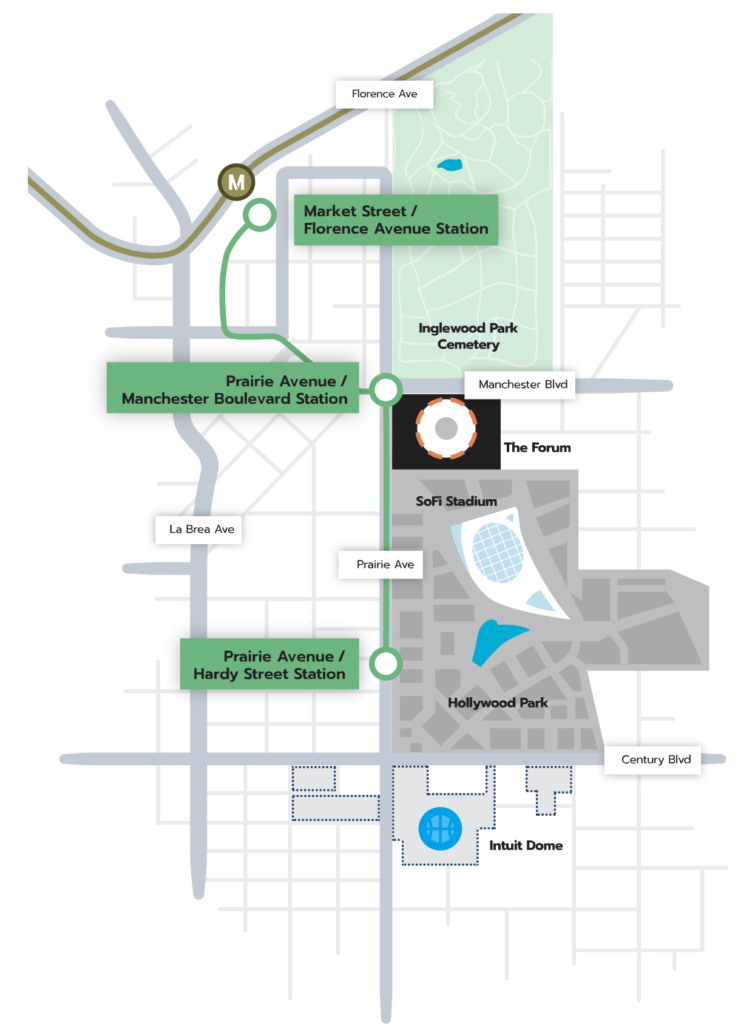While ETW was closed between Christmas and New Years, the Federal Transit Administration moved the Inglewood Transit Connector project to the “Engineering” stage of its Capital Investment Grant program, indicating that the project has completed its permitting and initial design phases and has received an overall project rating from FTA career staff. FTA is proposing that the CIG program pick up 50 percent of the project’s estimated $2.02 billion capital cost.
 The project would not be an extension of the existing L.A. Metro Rail system. Instead, it would be a self-contained, automated, 1.6-mile elevated heavy rail system running from a new station adjacent to the Florence station on Metro Rail’s A Line, running south down Prairie Avenue to two more stops.
The project would not be an extension of the existing L.A. Metro Rail system. Instead, it would be a self-contained, automated, 1.6-mile elevated heavy rail system running from a new station adjacent to the Florence station on Metro Rail’s A Line, running south down Prairie Avenue to two more stops.
While Inglewood is a majority-minority area that was left out of the original Metro Rail plan, the new project appears to be more about making it easier for people outside Inglewood to get in than for Inglewood residents to get connected. The stops are strategically located right in front of the new arenas for the L.A. Rams and Chargers (NFL), Clippers (NBA), and the mammoth Hollywood Park entertainment and casino complex being built by Rams owner Stan Kroenke on the old racetrack site between the two, which includes the NFL head offices.
(The project appears to be on a fast track because those venues will be used in the 2028 Summer Olympics.)
According to the revised project profile, when rated in October 2023, the project was given a “Medium” overall rating by the FTA staff on the 5-point scale of Low, Medium-Low, Medium, Medium-High, and High. Within that estimate, the Local Financial Commitment level was rated Medium, the Land Use was also rated Medium, and the project got a Medium-High for the Economic Development rating.
However, that project profile also contains ridership estimates that are startlingly low compared to other proposed mass transit projects also seeking CIG funding. According to the current monthly dashboard, there are six New Start CIG projects that have entered the Engineering phase or else have received Letters of No Prejudice allowing certain advance work to begin. (Not counting Bottineau LRT, which is on indefinite hold while the locals pick a new route.) According to their project profile pages on the FTA website, here are the estimated daily riderships in the final year of the project’s planning horizon, along with the estimated total capital cost for each project:
| CIG Projects Currently in the Engineering/LONP Phase |
| Source: FTA website |
|
|
|
|
|
|
|
|
Horizon |
HY Daily |
Total Cost |
Cost per HY |
| State |
Project |
Mode |
Year (HY) |
Ridership |
Million $ |
Daily Rider |
| CA |
Inglewood Transit Connector |
HR |
2040 |
4,300 |
$2,019 |
$469,488 |
| CA |
BART Silicon Valley Phase II |
HR |
2040 |
32,900 |
$12,237 |
$371,945 |
| IL |
CTA Red Line Extension |
HR |
2040 |
41,500 |
$3,948 |
$95,133 |
| SC |
Lowcountry Rapid Transit |
BRT |
2040 |
7,600 |
$625 |
$82,250 |
| NY-NJ |
Hudson River Tunnel |
HR |
2030 |
210,400 |
$14,591 |
$69,349 |
| TX |
VIA ART North-South Corridor |
BRT |
2040 |
13,500 |
$446 |
$33,060 |
A capital cost of $470 thousand per daily rider is a lot, even by California standards. However, we’re still not sure as to whether or not either of the two major variables here has been updated:
- if the projected capital cost has been updated to reflect the latest, significant escalation in heavy construction material costs; and
- if the projected ridership has been updated for the overall post-COVID transit ridership decrease.
To put the above numbers in perspective, here are the same metrics for some recently approved CIG projects:
| Some Recent CIG Projects With Executed FFGAs |
|
|
|
|
|
|
Horizon |
HY Daily |
Total Cost |
Cost per HY |
| State |
Project |
Mode |
Year (HY) |
Ridership |
Million $ |
Daily Rider |
| MN |
Southwest LRT |
LR |
unk. |
19,213 |
$2,003 |
$104,260 |
| CA |
Westside Purple Line Sec. 3 |
HR |
2035 |
36,100 |
$3,599 |
$99,703 |
| WA |
Lynnwood Link |
LR |
2026 |
51,000 |
$3,260 |
$63,928 |
| NY-NJ |
Second Avenue Subway |
HR |
2035 |
123,000 |
$6,949 |
$56,494 |

 The project would not be an extension of the existing L.A. Metro Rail system. Instead, it would be a self-contained, automated, 1.6-mile elevated heavy rail system running from a new station adjacent to the Florence station on Metro Rail’s A Line, running south down Prairie Avenue to two more stops.
The project would not be an extension of the existing L.A. Metro Rail system. Instead, it would be a self-contained, automated, 1.6-mile elevated heavy rail system running from a new station adjacent to the Florence station on Metro Rail’s A Line, running south down Prairie Avenue to two more stops.

